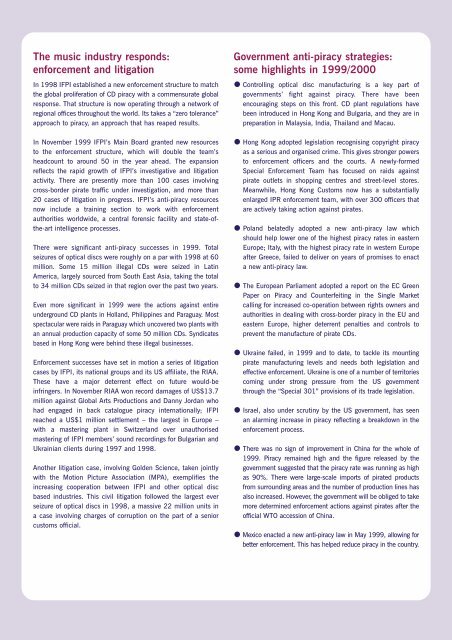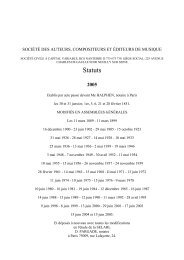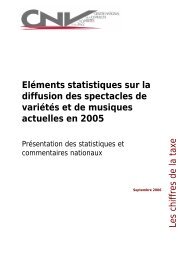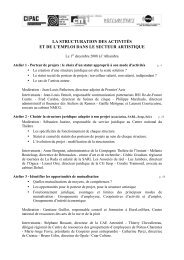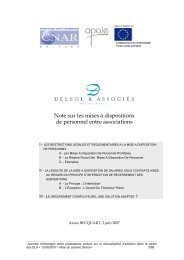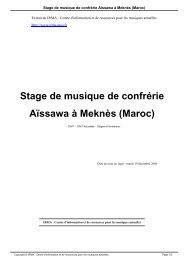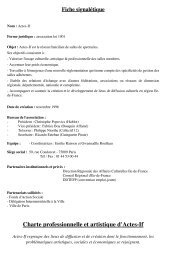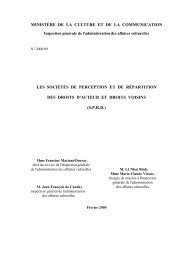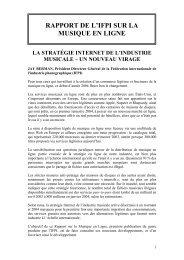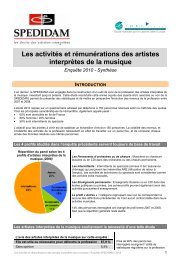Download Piracy Report 2000 - IFPI
Download Piracy Report 2000 - IFPI
Download Piracy Report 2000 - IFPI
Create successful ePaper yourself
Turn your PDF publications into a flip-book with our unique Google optimized e-Paper software.
The music industry responds:<br />
enforcement and litigation<br />
In 1998 <strong>IFPI</strong> established a new enforcement structure to match<br />
the global proliferation of CD piracy with a commensurate global<br />
response. That structure is now operating through a network of<br />
regional offices throughout the world. Its takes a “zero tolerance”<br />
approach to piracy, an approach that has reaped results.<br />
In November 1999 <strong>IFPI</strong>’s Main Board granted new resources<br />
to the enforcement structure, which will double the team’s<br />
headcount to around 50 in the year ahead. The expansion<br />
reflects the rapid growth of <strong>IFPI</strong>’s investigative and litigation<br />
activity. There are presently more than 100 cases involving<br />
cross-border pirate traffic under investigation, and more than<br />
20 cases of litigation in progress. <strong>IFPI</strong>’s anti-piracy resources<br />
now include a training section to work with enforcement<br />
authorities worldwide, a central forensic facility and state-ofthe-art<br />
intelligence processes.<br />
There were significant anti-piracy successes in 1999. Total<br />
seizures of optical discs were roughly on a par with 1998 at 60<br />
million. Some 15 million illegal CDs were seized in Latin<br />
America, largely sourced from South East Asia, taking the total<br />
to 34 million CDs seized in that region over the past two years.<br />
Even more significant in 1999 were the actions against entire<br />
underground CD plants in Holland, Philippines and Paraguay. Most<br />
spectacular were raids in Paraguay which uncovered two plants with<br />
an annual production capacity of some 50 million CDs. Syndicates<br />
based in Hong Kong were behind these illegal businesses.<br />
Enforcement successes have set in motion a series of litigation<br />
cases by <strong>IFPI</strong>, its national groups and its US affiliate, the RIAA.<br />
These have a major deterrent effect on future would-be<br />
infringers. In November RIAA won record damages of US$13.7<br />
million against Global Arts Productions and Danny Jordan who<br />
had engaged in back catalogue piracy internationally; <strong>IFPI</strong><br />
reached a US$1 million settlement – the largest in Europe –<br />
with a mastering plant in Switzerland over unauthorised<br />
mastering of <strong>IFPI</strong> members’ sound recordings for Bulgarian and<br />
Ukrainian clients during 1997 and 1998.<br />
Another litigation case, involving Golden Science, taken jointly<br />
with the Motion Picture Association (MPA), exemplifies the<br />
increasing cooperation between <strong>IFPI</strong> and other optical disc<br />
based industries. This civil litigation followed the largest ever<br />
seizure of optical discs in 1998, a massive 22 million units in<br />
a case involving charges of corruption on the part of a senior<br />
customs official.<br />
Government anti-piracy strategies:<br />
some highlights in 1999/<strong>2000</strong><br />
Controlling optical disc manufacturing is a key part of<br />
governments’ fight against piracy. There have been<br />
encouraging steps on this front. CD plant regulations have<br />
been introduced in Hong Kong and Bulgaria, and they are in<br />
preparation in Malaysia, India, Thailand and Macau.<br />
Hong Kong adopted legislation recognising copyright piracy<br />
as a serious and organised crime. This gives stronger powers<br />
to enforcement officers and the courts. A newly-formed<br />
Special Enforcement Team has focused on raids against<br />
pirate outlets in shopping centres and street-level stores.<br />
Meanwhile, Hong Kong Customs now has a substantially<br />
enlarged IPR enforcement team, with over 300 officers that<br />
are actively taking action against pirates.<br />
Poland belatedly adopted a new anti-piracy law which<br />
should help lower one of the highest piracy rates in eastern<br />
Europe; Italy, with the highest piracy rate in western Europe<br />
after Greece, failed to deliver on years of promises to enact<br />
a new anti-piracy law.<br />
The European Parliament adopted a report on the EC Green<br />
Paper on <strong>Piracy</strong> and Counterfeiting in the Single Market<br />
calling for increased co-operation between rights owners and<br />
authorities in dealing with cross-border piracy in the EU and<br />
eastern Europe, higher deterrent penalties and controls to<br />
prevent the manufacture of pirate CDs.<br />
Ukraine failed, in 1999 and to date, to tackle its mounting<br />
pirate manufacturing levels and needs both legislation and<br />
effective enforcement. Ukraine is one of a number of territories<br />
coming under strong pressure from the US government<br />
through the “Special 301” provisions of its trade legislation.<br />
Israel, also under scrutiny by the US government, has seen<br />
an alarming increase in piracy reflecting a breakdown in the<br />
enforcement process.<br />
There was no sign of improvement in China for the whole of<br />
1999. <strong>Piracy</strong> remained high and the figure released by the<br />
government suggested that the piracy rate was running as high<br />
as 90%. There were large-scale imports of pirated products<br />
from surrounding areas and the number of production lines has<br />
also increased. However, the government will be obliged to take<br />
more determined enforcement actions against pirates after the<br />
official WTO accession of China.<br />
Mexico enacted a new anti-piracy law in May 1999, allowing for<br />
better enforcement. This has helped reduce piracy in the country.


